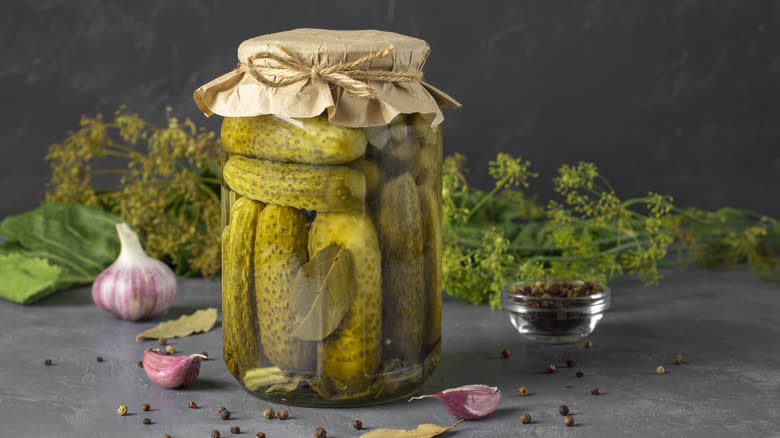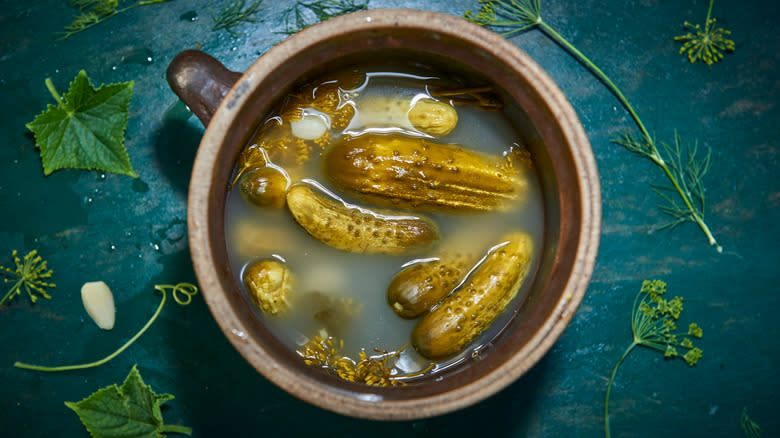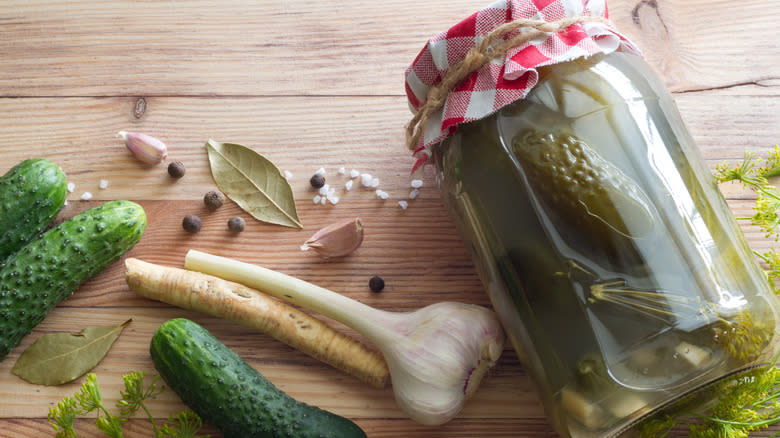Horseradish Is The Ingredient You're Missing For Spicy Homemade Pickles

Pickles pack in a lot of flavor for their size — just a wedge or a few slices are enough to add a zingy, acidic kick to any sandwich. Often, that tanginess comes along with a blast of bright dill, sharp garlic, a touch of sweetness, or other flavors based on whatever ingredients were included in the pickling brine. Naturally, then, pickles are great for imparting another sensation: spiciness. Spicy pickled cucumbers are a classic convenience store snack, and pickled peppers like jalapeños or habaneros are a great way to add some briny, flavorful heat to tacos, hot dogs, nachos, and plenty of other dishes. But if you're making your own pickles at home, there's one heat-packing ingredient you need to try: horseradish.
You might think of horseradish as something that usually accompanies Easter dinner or Passover Seder, but the root vegetable is almost as common in Eastern European and Jewish cuisine as pickles themselves. If you're looking for a clever way to spice up your next fermentation project, horseradish might be just the thing.
Read more: 12 Vegetables And Fruits That Used To Look Very Different
Put Away The Peppers

While many root vegetables can be starchy and sort of mild on their own, horseradish is a big exception. It's from the same family as mustard and wasabi, and like those, it's most commonly used as a condiment to introduce some pungency and sharpness to various dishes. Horseradish gets its heat from allyl isothiocyanate, a chemical released when the root is grated. It's meant to act as a defense mechanism for the plant, using its aggressive taste to deter animals from eating it — hence the irritating reaction it causes in your sinuses. But in balanced quantities, it's pleasantly tingly and brightens up rustic, fatty, and starchy foods.
There are about a million recipes for spicy pickles, but many of them use red pepper flakes as the heat-bringing ingredient. Cucumbers and other veggies pickled with sliced jalapeños or other fresh peppers are a common find, as well — and while all of those kinds of heat can be delicious, horseradish offers a different flavor profile. It brings a clean, fairly neutral but decidedly bright and sharp kind of spiciness that goes perfectly with classic deli sandwiches and simple meat-and-potatoes plates.
Turning Up The Heat

When you think of horseradish, chances are the first thing that comes to mind is the store-bought stuff that comes in a jar, already grated and mixed with vinegar. You can certainly use prepared horseradish in making spicy pickles at home, and some recipes call for it specifically. But for really unbeatable, hot little flavor bombs, your best bet is to buy actual fresh horseradish root. You're already going to add plenty of vinegar yourself, and even more importantly, fresh horseradish root is much more flavorful than the prepared stuff. Grate or slice the fresh horseradish just prior to use so there's little chance for the flavor and aroma to dissipate. Just watch the quantity you use, as that stuff can really pack a punch.
One reason for horseradish's popularity is its reputation as a healthy food. It's full of vitamins and minerals like calcium and magnesium, vitamin C, and zinc, and it's also a good source of antioxidants. It may even help reduce inflammation and improve respiratory health, so don't hesitate to help yourself to an extra spicy pickle or two with your next pastrami sandwich.
Read the original article on Daily Meal.

